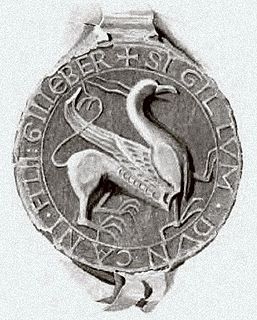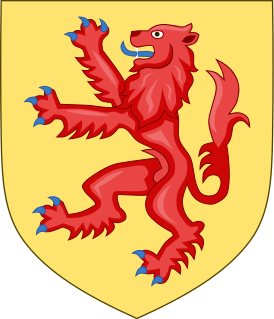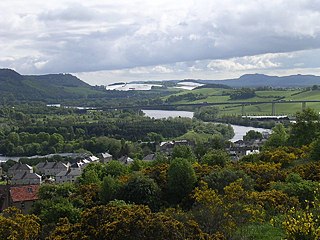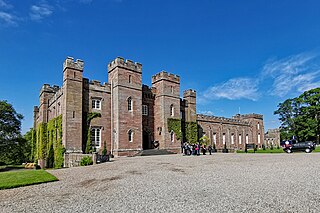Related Research Articles

Dál Riata or Dál Riada was a Gaelic kingdom that encompassed the western seaboard of Scotland and the north-eastern corner of Ireland, on each side of the North Channel. At its height in the 6th and 7th centuries, it covered what is now Argyll in Scotland and part of County Antrim in Northern Ireland. After a period of expansion, Dál Riata eventually became associated with the Gaelic Kingdom of Alba.

Malcolm IV, nicknamed Virgo, "the Maiden" was King of Scotland from 1153 until his death. He was the eldest son of Henry, Earl of Huntingdon and Northumbria and Ada de Warenne. The original Malcolm Canmore, a name now associated with his great-grandfather Malcolm III, he succeeded his grandfather David I, and shared David's Anglo-Norman tastes.
The Earl of Fife or Mormaer of Fife was the ruler of the province of Fife in medieval Scotland, which encompassed the modern counties of Fife and Kinross. Due to their royal ancestry, the earls of Fife were the highest ranking nobles in the realm, and had the right to crown the king of Scots.

Fergus of Galloway was a twelfth-century Lord of Galloway. Although his familial origins are unknown, it is possible that he was of Norse-Gaelic ancestry. Fergus first appears on record in 1136, when he witnessed a charter of David I, King of Scotland. There is considerable evidence indicating that Fergus was married to an illegitimate daughter of Henry I, King of England. It is possible that Elizabeth Fitzroy was the mother of Fergus's three children.

Donnchadh was a Gall-Gaidhil prince and Scottish magnate in what is now south-western Scotland, whose career stretched from the last quarter of the 12th century until his death in 1250. His father, Gille-Brighde of Galloway, and his uncle, Uhtred of Galloway, were the two rival sons of Fergus, Prince or Lord of Galloway. As a result of Gille-Brighde's conflict with Uhtred and the Scottish monarch William the Lion, Donnchadh became a hostage of King Henry II of England. He probably remained in England for almost a decade before returning north on the death of his father. Although denied succession to all the lands of Galloway, he was granted lordship over Carrick in the north.
Níall of Carrick was the second man to bear the title Mormaer, or Earl, of Carrick. He was successor of mormaer Donnchadh of Carrick. Originally he was believed to be the son of Donnchadh, however, it is now believed that he was more likely his grandson, the son of Donnchadh's oldest son and heir Cailean mac Donnchadh. Cailean, also known as Colin and Nicholaus of Carrick, predeceased his father and therefore upon Donnchadh's death in 1250, the title of Mormaer came to Niall. It has been suggested that Cailean's wife, Niall's mother, was a daughter of Niall Ruadh, briefly king of Tir Eoghain. Niall's grandfather Donnchadh held lands in Ireland, such a marriage of his son would have reinforced Donnchadh's Irish alliances and would account for the use of the name Niall. It would also explain the strong alliance with the Ó Neill held by Niall's grandsons. As the son of Cailean, Niall had one sister, Afraig, who married Gilleasbaig of Menstrie, a baron of Clackmannanshire who was the first attested man to bear the surname "Campbell".

Somerled, known in Middle Irish as Somairle, Somhairle, and Somhairlidh, and in Old Norse as Sumarliði[ˈsumɑrˌliðe], was a mid-12th-century Norse-Gaelic lord who, through marital alliance and military conquest, rose in prominence to create the Kingdom of Argyll and the Isles. Little is certain of Somerled's origins, although he may have been born in northern Ireland and appears to have belonged to a Norse–Gaelic family of some prominence. His father, GilleBride, of royal Irish ancestry, appears to have conducted a marriage alliance with Máel Coluim mac Alaxandair, son of Alexander I of Scotland, and claimant to the Scottish throne. During a period of alliance with David I of Scotland, Somerled married Ragnhild, daughter of Óláfr Guðrøðarson, King of Man and the Isles in 1140. In 1153, Olaf of Man died and was succeeded by his son, Godred. But Godred Olafsson was a very unpopular ruler. Somerled was asked by Thorfinn Ottarson, a Manx chief, to allow Somerled's son, Dugall, to be appointed king of Man and the Isles. Somerled agreed and with 80 ships confronted Godred off the coast of Islay on January 5–6, 1156. After the sea battle, Somerled and Godred divided the Kingdom of Man and the Isles between them but Godred did not accept Dugall as King of Man. Accordingly, two years later, Somerled defeated and drove Godred from power. Dugall continued as King of Man and Somerled thus ruled the entire kingdom of Argyll, Man and the Isles until his death.

Donnchadh IV, Earl of Fife [Duncan IV] (1289–1353) was sometime Guardian of Scotland, and ruled Fife until his death. He was the last of the native Scottish rulers of that province.
The Kingdom of Alba was the Kingdom of Scotland between the deaths of Donald II in 900 and of Alexander III in 1286, which then led indirectly to the Scottish Wars of Independence. The name is one of convenience, as throughout this period the elite and populace of the Kingdom were predominantly Pictish-Gaels or later Pictish-Gaels and Scoto-Norman, and differs markedly from the period of the House of Stuart, in which the elite of the kingdom were speakers of Middle English, which later evolved and came to be called Lowland Scots. There is no precise Gaelic equivalent for the English terminology "Kingdom of Alba", as the Gaelic term Rìoghachd na h-Alba means 'Kingdom of Scotland'. English-speaking scholars adapted the Gaelic name for Scotland to apply to a particular political period in Scottish history during the High Middle Ages.
Scottish Society in the High Middle Ages pertains to Scottish society roughly between 900 and 1286, a period roughly corresponding to the general historical era known as the High Middle Ages.

The High Middle Ages of Scotland encompass Scotland in the era between the death of Domnall II in 900 AD and the death of King Alexander III in 1286, which was an indirect cause of the Wars of Scottish Independence.
Cailean of Carrick or Cailean mac Donnchadh was the son of Donnchadh, Earl of Carrick, and probably the father of Niall, Earl of Carrick. Although once heir to the earldom of Carrick, Cailean appears to have died before 1250.

The Ó Dálaigh were a learned Irish bardic family who first came to prominence early in the 12th century, when Cú Connacht Ó Dálaigh was described as "The first Ollamh of poetry in all Ireland".

Political and military events in Scotland during the reign of David I are the events which took place in Scotland during David I of Scotland's reign as King of Scots, from 1124 to 1153. When his brother Alexander I of Scotland died in 1124, David chose, with the backing of Henry I of England, to take the Kingdom of Alba for himself. David was forced to engage in warfare against his rival and nephew, Máel Coluim mac Alaxandair. Subduing the latter took David ten years, and involved the destruction of Óengus, mormaer of Moray. David's victory allowed him to expand his control over more distant regions theoretically part of the Kingdom. In this he was largely successful, although he failed to bring the Earldom of Orkney into his kingdom.

The Davidian Revolution is a name given by many scholars to the changes which took place in the Kingdom of Scotland during the reign of David I (1124–1153). These included his foundation of burghs, implementation of the ideals of Gregorian Reform, foundation of monasteries, Normanisation of the Scottish government, and the introduction of feudalism through immigrant Norman and Anglo-Norman knights.

Gowrie is a region in central Scotland and one of the original provinces of the Kingdom of Alba. It covered the eastern part of what became Perthshire. It was located to the immediate east of Atholl, and originally included the area around Perth, though that was later detached as Perthia.

Geoffrey was a 12th-century Anglo-Norman Benedictine monk and abbot. Of Anglo-Norman origin, he became monastic head of the Benedictine priory at Canterbury, before moving to Scotland to be the first Abbot of Dunfermline. As abbot he presided over the construction of the new monastery building, the immigration of English monks and settlers, and the accumulation of enough wealth to make Dunfermline Abbey the richest Benedictine monastic house in the Kingdom of Scotland.

Scone is a town in Perth and Kinross, Scotland. The medieval town of Scone, which grew up around the monastery and royal residence, was abandoned in the early 19th century when the residents were removed and a new palace was built on the site by the Earl of Mansfield. Hence the modern village of Scone, and the medieval village of Old Scone, can often be distinguished.

Christina of the Isles was a fourteenth-century Scottish noblewoman. She was daughter of Ailéan mac Ruaidhrí, and a leading member of Clann Ruaidhrí. Although Ailéan had two sons, Lachlann and Ruaidhrí, both appear to have been illegitimate, whereas Christina was legitimate, and possibly a daughter of Ailéan's wife, Isabella.

Government in medieval Scotland, includes all forms of politics and administration of the minor kingdoms that emerged after the departure of the Romans from central and southern Britain in the fifth century, through the development and growth of the combined Scottish and Pictish kingdom of Alba into the kingdom of Scotland, until the adoption of the reforms of the Renaissance in the fifteenth century.
References
- Barrow, G. W. S. (1992), Scotland and its Neighbours in the Middle Ages, London: The Hambledon Press, ISBN 1-85285-052-3
- McNeill, Peter G. B.; MacQueen, Hector L.; Lyons, Anna May, eds. (2000), Atlas of Scottish History to 1707 (reprinted with corrections ed.), Edinburgh: The Scottish Medievalists and Department of Geography, University of Edinburgh, ISBN 0-9503904-1-0